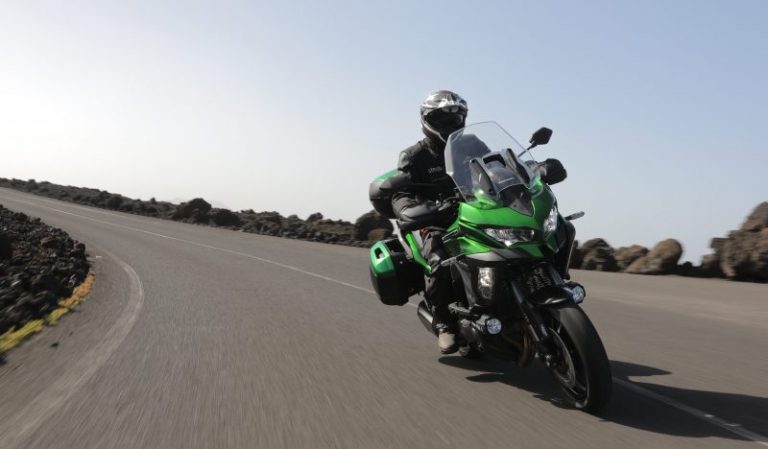Julian Challis visited in the Canary Islands to test the Kawasaki Versys 1000, which has received some big updates for 2019.
To the left, the azure depths of the Atlantic Ocean disappear towards a distant horizon as white-crested waves crash onto the jagged shoreline. Perched some forty feet above the water, a ribbon of smooth tarmac tracks the coast, cutting a long scar into the black volcanic rocks that dominate the landscape.
Emerging into the camera’s frame, the distinctive angular profile of the bike comes into focus, the metallic green paint glinting in the warm, February sun before it storms past the lens, leaving motes of dust gently spiralling back towards the deserted road…
We’re at the launch of the 2019 Kawasaki Versys 1000 in the Canary Islands, and the road in question is on the west coast of Lanzarote, just a stone’s throw from the Timanfaya National Park and the volcano that created the island’s distinctive and barren landscape nearly 300 years ago. In terms of the Versys 1000, the first one came out far more recently, back in 2012 with seven different incarnations of the litre capacity bike since then, but the last major update was four years ago.
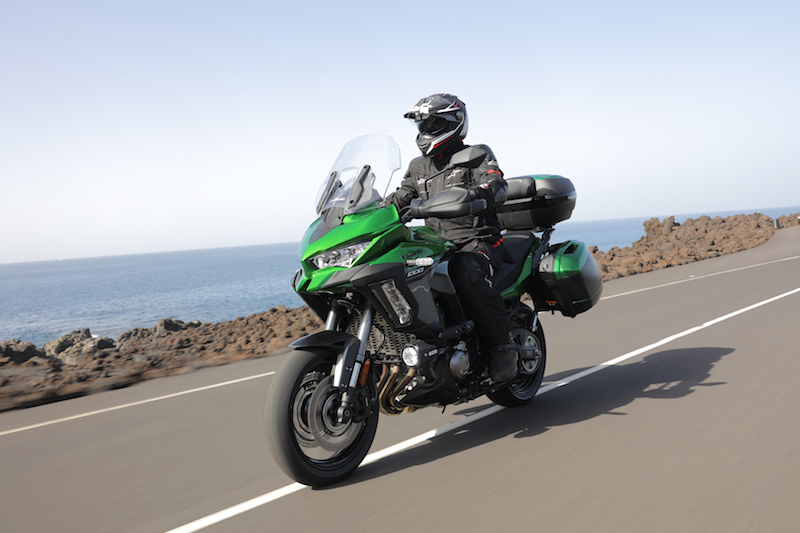
All guns blazing
The 2015 model received a full cosmetic facelift and a gentle uplift in its specification. For 2019, Kawasaki has come out with all guns blazing and thrown the proverbial kitchen sink at the bike in a determined and focussed effort to match its competitors and meet the expectations of an increasingly demanding audience in an increasingly packed marketplace.
At this stage, it’s worth qualifying that although the launch was nominally for the Versys 1000, of the six variants available in the range, from the basic 1000 Tourer, the 1000 Tourer Plus and 1000 Grand Tourer to the SE Tourer and the SE Tourer Plus, all the test bikes were the top of the range Versys 1000 SE Grand Tourer, all in the same emerald green livery.
OK, there was a base model 1000 bike in KTM orange – sorry, ‘Candy Steel Furnace Orange / Metallic Spark Black’ – in the foyer of the launch venue, but it remained there for the duration. Kawasaki was clearly determined to show us its best and, with sales between the SE and base models slanted roughly 70/30 towards the higher-spec bike, the logic was undeniable. And anyway, who’s going to want to talk to the drummer when the lead singer is in the room?.
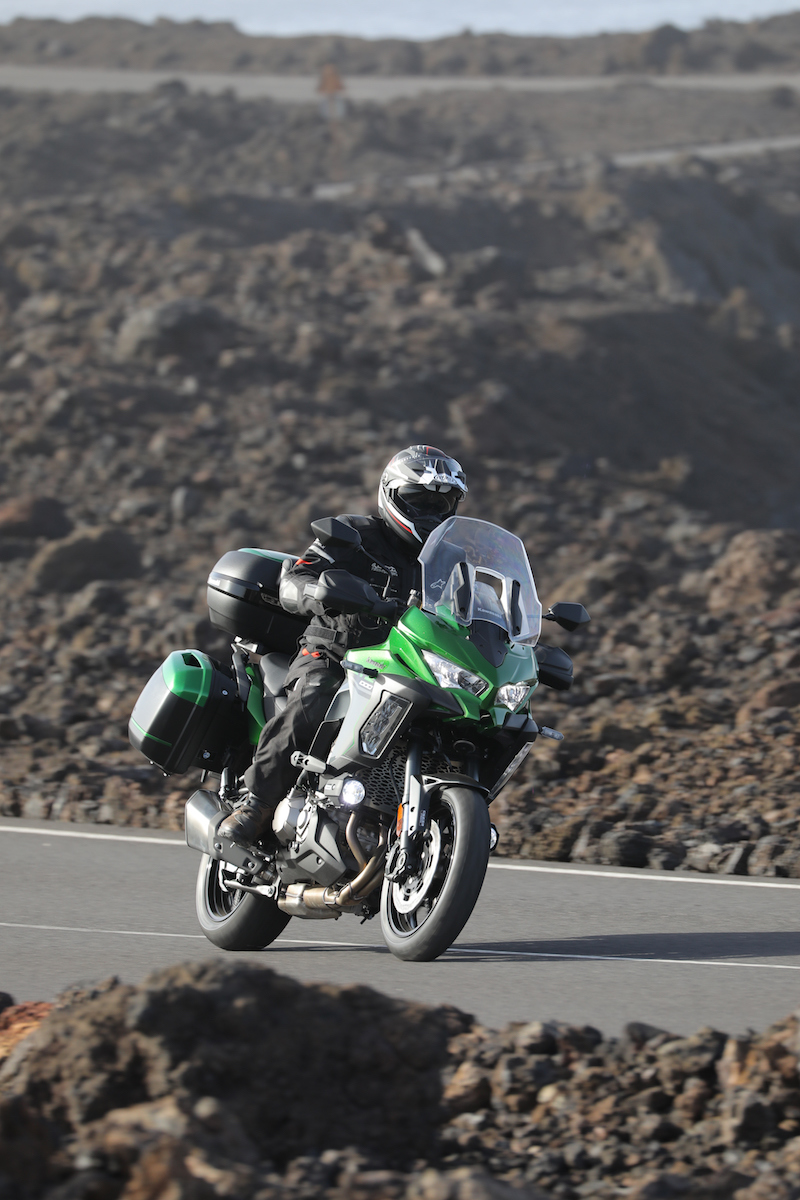
Back to basics
So, what is the Versys, or ‘Versatile System’ as the name comes from, all about? The heart of the bike is that big in-line four motor which, within the adventure bike sector, is pretty rare, save for BMW’s S 1000 XR. The motor in the 2019 model is unchanged from the previous model, the 1043cc 16-valve lump putting a modest 118bhp, some forty below the BMW and the Ducati Multistrada 1260, too.
While it might seem odd to draw these comparisons quite so early, it’s these bikes that Kawasaki identifies as the natural competition to the Versys – all three are firmly intended for road-based adventure touring, all three run 17-inch wheels front and back and, importantly, none of them are particularly competent or indeed enjoyable away from the blacktop. Whether there are actually potential buyers struggling to decide between these three bikes however, is open to question…
Surrounding the engine, there’s a twin-tube aluminium chassis to hold it all together, although with such extensive bodywork, the only parts of the frame you can actually see are the vast alloy side plates that sweep from the side panels down to the swingarm pivot and the narrow tubing of the subframe that supports the pillion pegs.
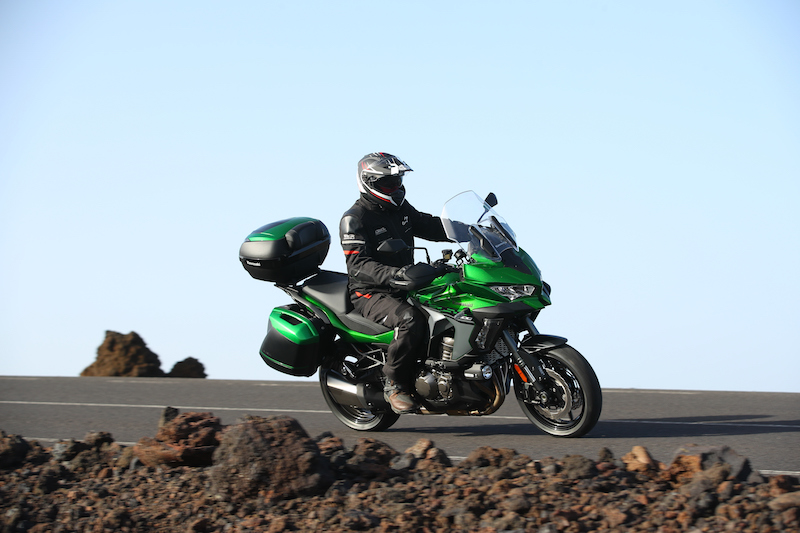
Angular and choppy
Having just mentioned the bodywork, it’s probably worth dealing with the elephant in the room before we go any further. The styling on the Versys is nothing if not individual. When we posted initial pictures of the bike on the Adventure Bike Rider Facebook page, many of the comments were far from complimentary, and given the bike’s angular and choppy design, it’s easy to see that designer Jiwon Seo’s vision for the 2019 model may not be to everyone’s taste.
Seo was also the designer for the Z1000SX, and it may be that the aggressive profile and multi-layered look is more at home on a sports bike than we are perhaps used to on adventure bikes. Whatever the thinking behind the look of the Versys, there will be some that like it and some that don’t – just like any bike really!
Our first ride on the bike came as we left the launch HQ and headed away from the coast and up into the mountains to the north of the resort. The bike’s cockpit is beautifully open and uncluttered, the large, adjustable fairing sitting far away from the rider and offering a nicely cosseted feeling behind it.
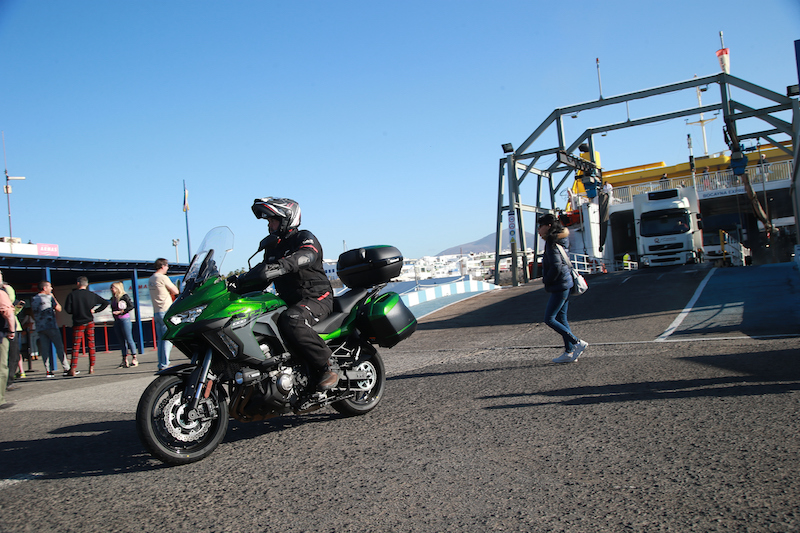
Friction throttle system
The throttle on the Versys is now a complete fly-by-wire system, but the engineers have cleverly applied a friction system that exactly mirrors a normal twin cable set-up. If we hadn’t been told, we would not have noticed, but what you do notice is the very precise fuelling that this and the new electronic throttle valves allow, and the bike is flawless from tick over to full chat and back again.
Given the touring capabilities of the Versys, the decision to keep with chain drive seems odd however. With absolutely no off-road pretensions for the bike, having shaft drive would seem an obvious, if not obligatory, inclusion for the Kawasaki. When we quizzed the production team about this omission back at the hotel, there was no clear answer, save for some talk about trying to save weight.
On a bike of these dimensions and intended use, the reasoning seemed unconvincing. Not that there’s anything wrong with the caramel smooth chain transmission on the Versys, it’s just a shaft would be more appropriate for the bike and the likely owners.
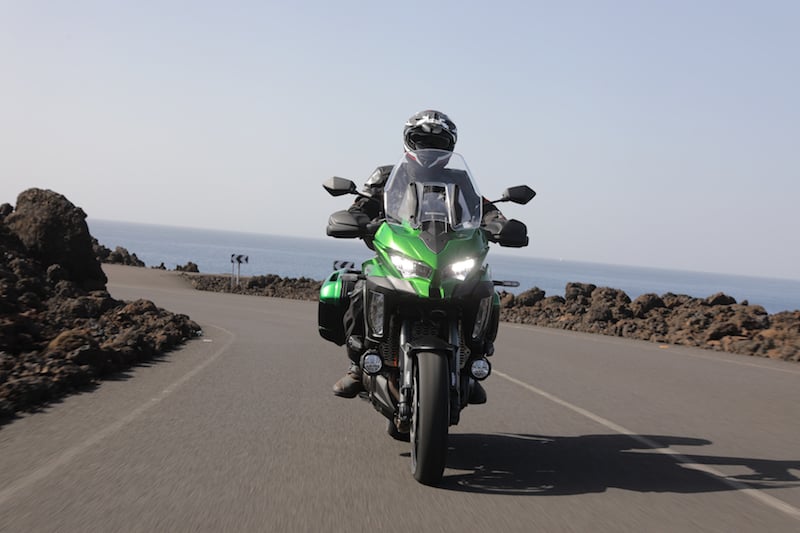
Effective quick-shifter
The clutch on the bike retains a conventional cable which, on a bike that will top £16,000 (fully kitted), seems a tad old-school. It highlights the Japanese manufacturer’s bizarre and continued reluctance to use hydraulic clutches such as those that have been included on European bikes a quarter of the capacity of the Versys for decades.
The clutch itself is bang up-to-date with a full slipper and assist system that sees it operate effortlessly whenever called upon, but with a neat and effective quick-shifter in place, gear changes are pretty much a clutch-free zone anyway. I’m still trying to get myself into the habit of using quick-shifters all the time, but as soon as I’m not concentrating, it’s hard to forget decades of dipping the throttle and clutching to move around the box. My main concern is that if I do get used to it, my poor old TDM 850’s gears are in for a seriously hard time…
Returning to the cockpit, the clocks on the Versys SE are a pleasing combination of old and new school, with an analogue tacho sitting to the left of a well-designed and clear TFT screen. OK, it’s not BMW GS-sized, but it’s plenty big enough to give good information at a glance. The display can be altered via the toggle switches on the left-hand binnacle, with a secondary button on the right.
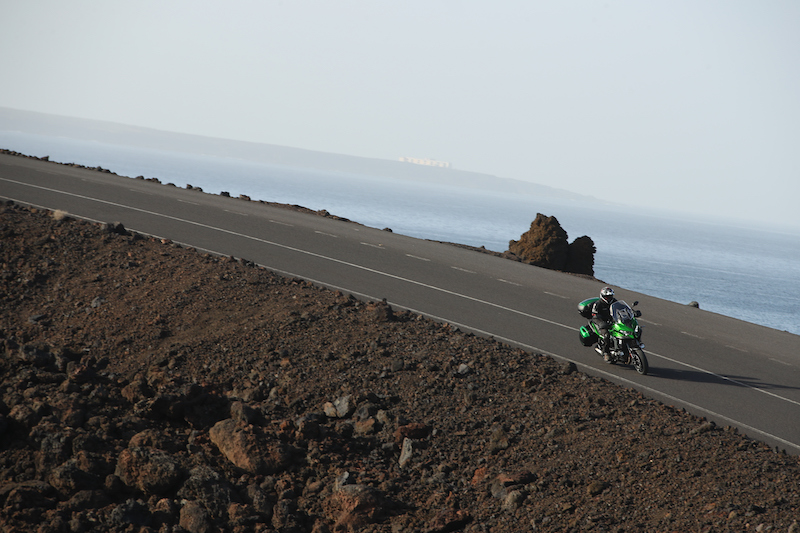
Riding modes
If you chose the base model, things are a bit more, err, basic in the dashboard department, but as we didn’t get to see one in the flesh, it’s hard to say whether we’d have been horrified by a digital display or indeed upset by the lack of thin film transistors!
The main thing you are going to want to adjust on the bike is the riding modes, and as the bike is not intended to tackle anything remotely dirty, there are just four basic modes – ‘Sport’, ‘Road’ and ‘Rain’ and these are supplemented on the SE model by the infinitely tuneable ‘Rider’ mode. Given the fantastic weather and unexpectedly good roads in the Canaries, there was little desire to move the bike away from the spirited ‘Sport ‘mode that delivers heaps of fun across the range.
If you bought the Versys and stayed on Lanzarote, ‘Rain’ mode, like the heated grips, would be as unused as a Debrett’s Handbook in the Whitehouse. Leaving the bike locked in ‘Sport’ and the screen set on high (a slightly fiddly process that really requires two hands and being stationary to adjust), the bike can just be ridden and thoroughly enjoyed.
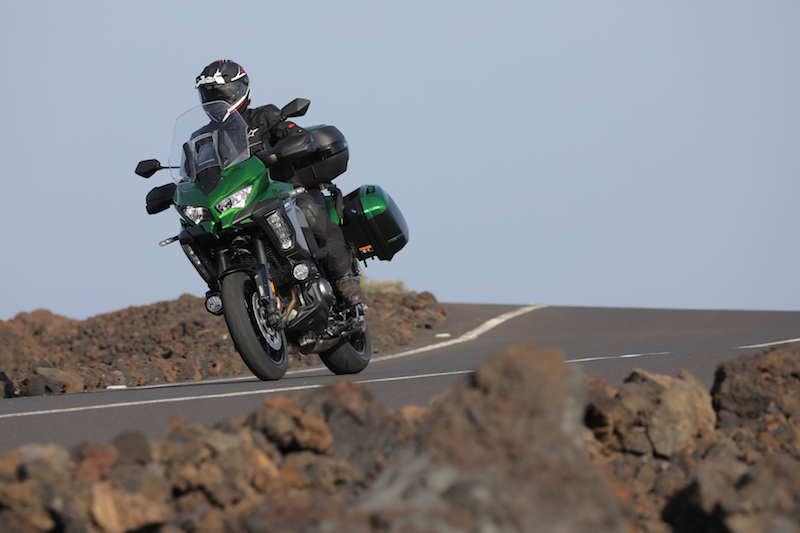
Exploring alone
With the photographs and videos suitably in the can, the Kawasaki staff threw us a beautiful, unexpected curve ball by snapping a TomTom into the GPS cradle, plumbing in the co-ordinates for Playa Blanca and telling us to go and explore the island and meet them at the ferry port in three-hours time.
Compared to the usual routine of following each other like a crocodile of five-year-olds, the chance to ride the Versys like you would if you’d hired a bike on such a stunningly good riding location made everybody’s face light up like we’d been let out of school early.
I headed towards the top of the island on a wonderful mixture of fast flowing roads, tight mountain hairpins and slower meanders through the picturesque villages that dot the landscape. For a big bike (the Versys weighs in at over 250kg) it’s beautifully nimble on the road, and on slower manoeuvres and even U-turns, the generous steering lock and great balance don’t ever make you feel like you’ll drop it – something my Ténéré still can’t manage!
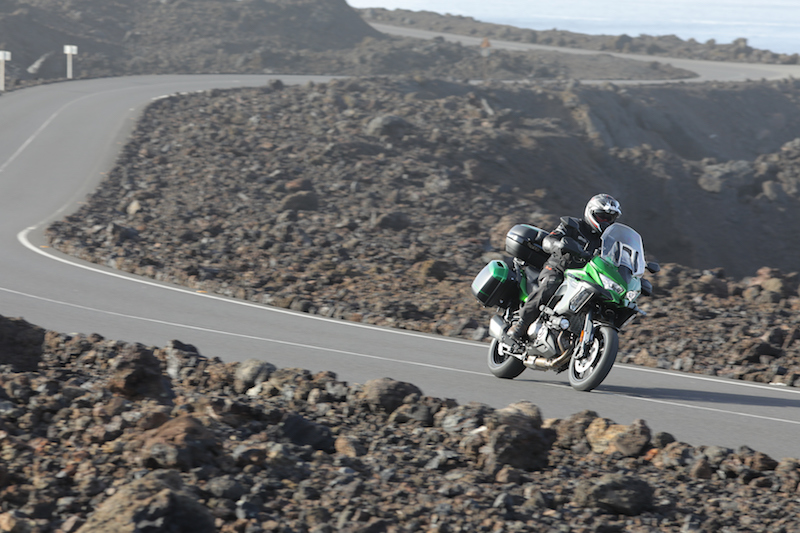
Rock-solid and stable
The SE model has all the electronic trickery applied to the suspension both back and front in the form of the KECS (Kawasaki Electronic Control Suspension) systems and, on the road, the bike is beautifully composed at all times. The bike runs the same chunky 43mm USD Showa Cartridge forks as the ZX10R SE at the front and a BFRC (balance free rear cushion) Lite shock from Showa at the rear, this being operated via a horizontal linkage.
Both units have stroke sensors, the rear also having an electronic preload adjuster which stiffens things up according to the selected weight setting. Kawasaki has also fitted incredibly accurate and fast-acting solenoids to the suspension that are capable of reacting within a millisecond, providing all but instantaneous response to whatever the road and the bike is doing. Teamed up with the Bridgestone Sport Touring T31 tyres, the bike is rock solid and stable from the get-go.
But if you do want even more fine-tuning to the already impressive suspension, the ‘Rider’ mode on the SE model will also allow you to vary the compression and rebound damping to an almost infinite degree, and what’s more, you don’t even need to be on the bike at the time thanks to the all-new Rideology App launched with the bike. The days of breaking out a C spanner and turning adjusters through thirteen clicks to the left are long since gone… Oh, unless you buy the stock Versys.
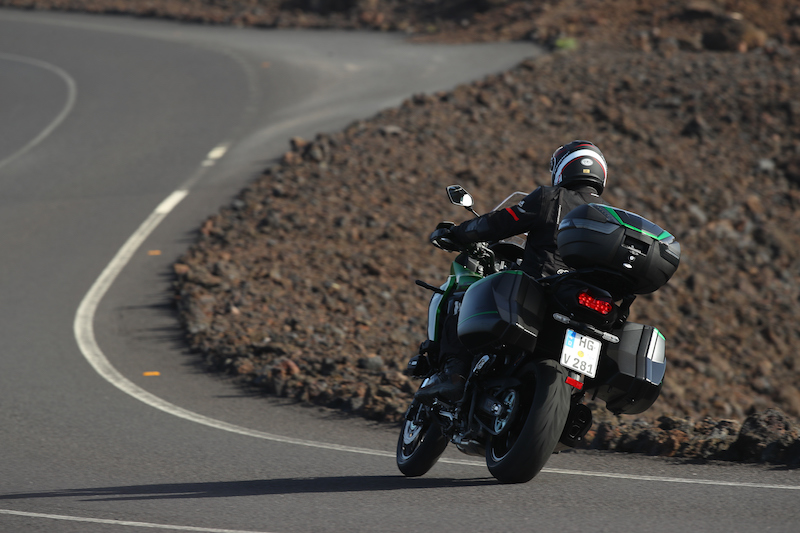
Electronic trickery
The electronics don’t stop at the suspension though, and in a flurry of acronyms, Kawasaki has fitted the new Versys with its KTRC (Kawasaki TRaction Control) system and the KCMF (Kawasaki Cornering Management Function) technology that looks after the braking systems while cornering in conjunction with the KIBS (Kawasaki Intelligent anti-lock Brake system) and the KECS program and the Bosch IMU.
If it’s all too much to take and understand, all you really need to know is that for every moment you are on the Versys, a host of computer systems are ensuring the suspension, power and brakes are operating to their absolute best.
After a couple of hours of blasting around Lanzarote, I headed for Playa Blanca to eat my packed lunch by the waterside. The Kawasaki certainly attracted the admiring looks from the passing holidaymakers, the deep green livery glittering in the midday sun. They’d probably be even more impressed if they knew that the paint was quite so clever and actually heals itself if scratched.

Self-healing paint
Yes, you did read that correctly – the Versys 1000 has ‘highly durable paint’ in the areas likely to see the most wear. The paint is effectively not quite set, so if it does get scratched, it will gradually flow back and repair the damage over a few days so that you’d never know there had been any. While this is indeed a truly ground-breaking innovation on a motorcycle. Kawasaki was at pains to clarify that, unlike the Terminator T-1000, the Versys SE 1000 will not actually reform itself after a crash. Shame.
We took the 1:30 ferry from Lanzarote for the 25-minute trip across to Fuerteventura, the bikes strapped to the decks of the vast catamaran with more force than perhaps the crash bars were meant to tolerate. Once unloaded, it was time to fire up the SatNav and go exploring again, the sole appointment being dinner at 8 pm. Leaving the port through the suburbs and out into open country, I was surprised to find myself on the island’s sole stretch of motorway, the ambitiously named F1.
With nine miles of deliciously flat and sweeping three-lane tarmac ahead of me (and no speed cameras), it was time to open the taps on the Versys and see what it could do. With a wonderful howl from the air intakes, the motor propelled the bike forwards in an intensely satisfying rush as I clicked through the box and into top.
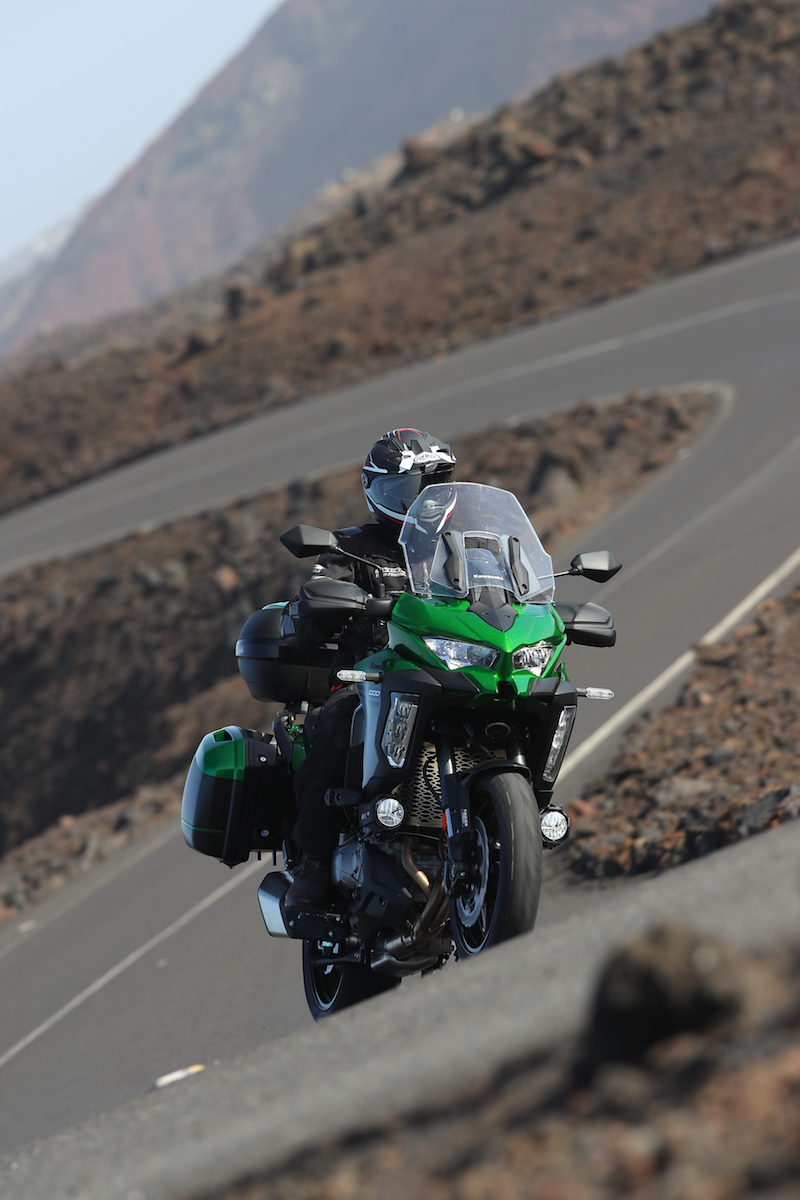
170kph and beyond
The digital speedo headed past 160, then 170 and there was still plenty to spare as the volcanic landscape began to blur on either side of the road. Pushing it any more with those big, empty panniers and the large top box behind would perhaps be unwise. The fairing works well at this speed too, keeping a calm cocoon in front of the rider, but with just enough airflow from the central vent to enjoy the warm breeze. The Versys might not be top of the table in the horsepower league, but there’s plenty enough to make you beam like a tabby from Warrington.
With the end of the F1 approaching, it was a good time to properly test the Kawasaki’s brakes. Equipped with a pair of massive radial monobloc calipers sourced from the Z1000 and with a radial lever gripping onto a set of dinner-plate dimensioned 310mm petal discs, the brakes on the Versys are visually impressive and indeed very effective, hauling up the bike with a comforting precision, supported by the single 250mm single disc at the rear and, of course, the all-seeing eye of the intelligent ABS software.
Away from the big braking necessary to stop 250kg of finest Japanese metal at motorway speeds, the brakes are also delicate and assured on the twisties that followed on from the brief dash on the F1. The roads snaked in and out of a series of tiny, sun-baked villages and back out to wide, open plains of dry volcanic rock and, with the cruise control set, the Versys devoured the miles effortlessly.
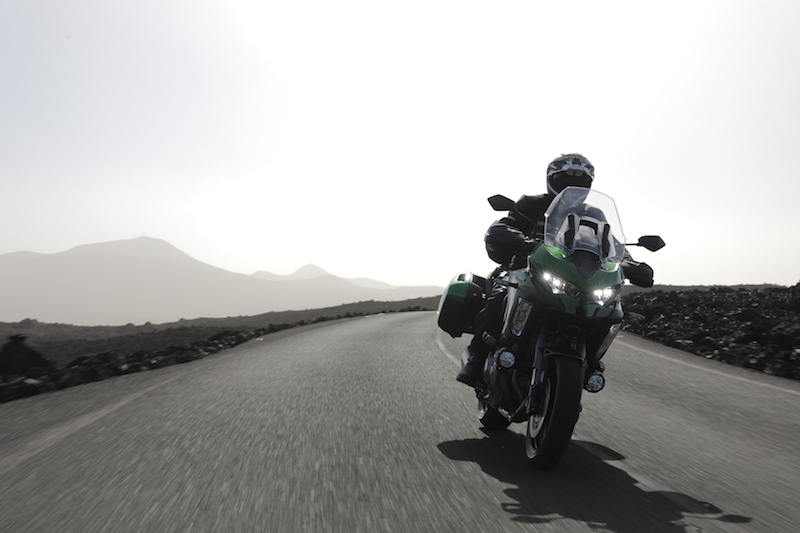
Upright and comfortable
The seat is comfortable, the bars wide and nicely profiled and the upright riding position allows you to enjoy the scenery and the ride – a pretty perfect combination. After two glorious hours of unhurried and relaxed riding around Fuerteventura’s fantastic roads, I headed for the resort of Ajuy on the west coast of the island for a glass of cool lemonade as the pale sun sank towards the horizon. These are the sort of days motorcycles are made for…
Over the course of the two days in the Canaries I’d gone from a relative ambivalence to the Versys to a definite enthusiasm for its capabilities. With the sector already wide and getting ever wider, there are multiple interpretations of what exactly defines an adventure bike. Kawasaki has decided to firmly fix its bike in the road end of the market rather than the dual-sport end and, as such, has been able to concentrate on making the Versys into a very accomplished road bike, instead of an indifferent bike that could do both. And, as many riders are quite happy to have their adventures away from the rough stuff, this is a pretty shrewd move.
This bike would be the perfect companion to explore the delights of Europe, to take in the finer points of France, experience the splendour of the Italian Alps or cruise through the cool forests of West Germany. It may be no coincidence that the Versys we rode was called the Grand Tourer…
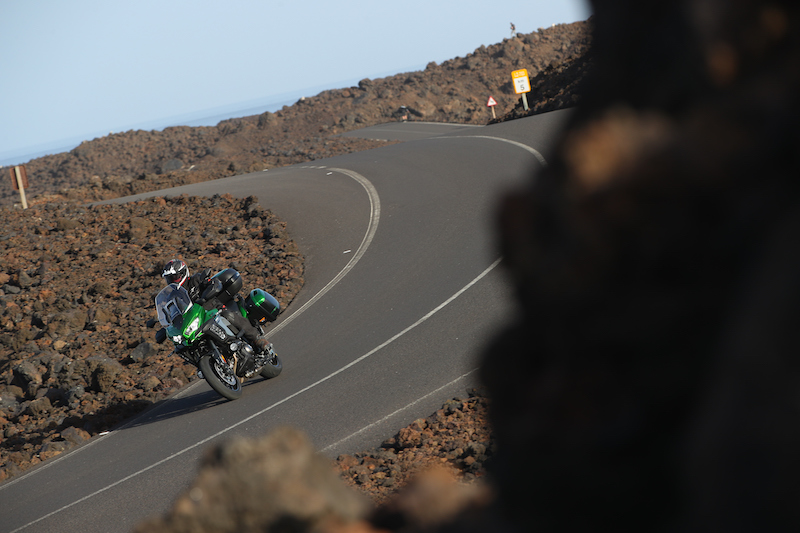
ABR verdict
As a commuter
The Versys 1000 is a physically large bike so couldn’t really be considered unless you are commuting to Cologne, in which case it would be ideal. Maybe its younger sibling, the 300 Versys, or even the 650, might prove a better option for conquering the metropolis?
As a weekend tourer
The Versys would easily fit the bill as a weekend tourer, but don’t be expecting it to excel at scratching round the backroads and carving tight lines round rural lanes. Take a chill pill, find some flowing roads and load up some Darius Brubeck. Quartet on the Bluetooth. Perfect.
As an off-roader
Let’s be entirely clear here, don’t take the Kawasaki Versys 1000 off road unless you crave disappointment, hospital food and very large repair bills. Very gentle gravel trails would be the extent of this bike’s off-road capability, but you’d be missing the point of the bike there.
As a continental road tourer
Now we are talking. If you want to saddle up and explore the capitals of Europe with ease, then the Versys will prove the ideal companion. Great luggage options, all-day comfortable seat and a smooth, powerful engine with every conceivable electronic aid fitted – it’s a great tourer.
As an RTW overlander
If you could guarantee that you could find a route around the world on tarmac, or maybe if you are Nick Sanders, then by all means give the Versys a go. One thing’s for sure, you’d be comfortable on your ride, but with all of the electronic wizardry, breakdowns could be problematic.
As a pillion carrier
Back on safe territory now, as your nearest and dearest will positively enthuse as to the generous accommodation you’ve provided for them. A raised seat, a top box to lean against and wonderfully plush suspension – it’s like a Parker Knoll recliner back there!
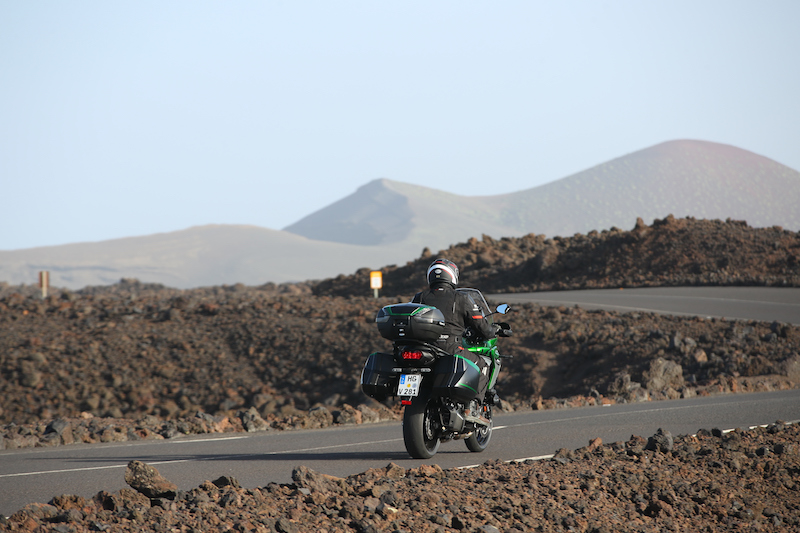
Bells and whistles
If you buy the Versys 1000 SE Grand Tourer, you get a host of goodies to improve your experience. These include:
- Four selectable riding modes
- Quick shifter
- 47 l Top case System with Backrest
- Large Windscreen
- 2 x 28-litre panniers with inner bags
- LED Cornering lights
- Tank pad
- Phone connectivity
- Frame sliders
- Heated grips
- GPS Bracket
- Highly durable paint
- LED Fog lamps
- TFT Screen
- Kawasaki Electronic Control Suspension
- Handguards
But don’t think all this comes cheap – add the whole lot and it puts £4,700 on the price of the stock Versys 1000.
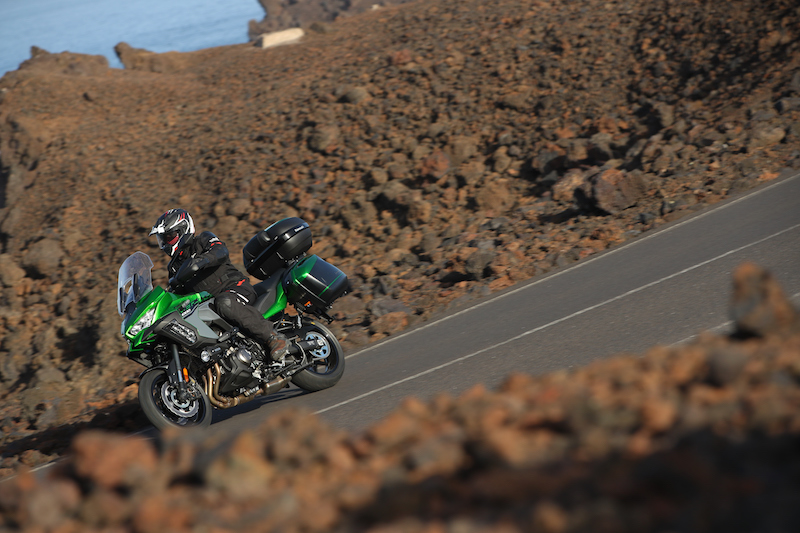
Specs at a glance
Engine: Liquid-cooled, 16V DOHC four-stroke motor
Capacity: 1043cc
Output: 118bhp @ 9,000rpm
Torque: 102Nm @ 7,300rpm
Suspension: Front; 43mm fully-adjustable USD Showa forks, electronic compression and rebound adjustment using KECS. Rear; fully-adjustable Showa BFRC shock with horizontal linkage. Electronic adjustment of rebound, compression and preload
Brakes: Front; Twin 310 petal discs with radially mounted Brembo monoblock piston calipers and radial lever. Rear; Single 250mm petal disc, single piston caliper
Tyres: Front; 120/70 ZR17 M/C. Rear; 180/55 ZR17 M/C. Bridgestone Sport Touring T31
Weight: 253kg as standard/257kg for SE
Tank capacity: 21L
Seat height: 840mm standard, 820mm low
Prices: From £11,342 to £16,042


